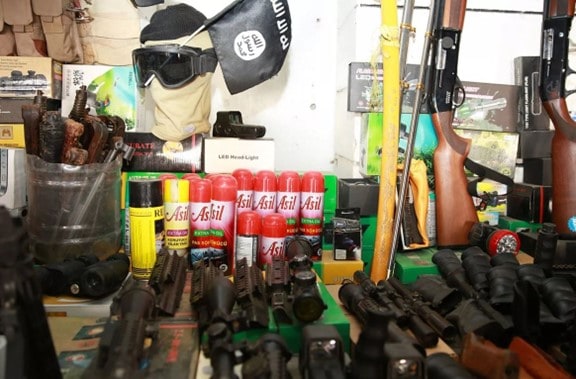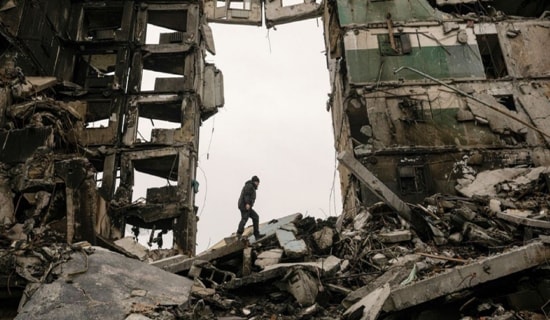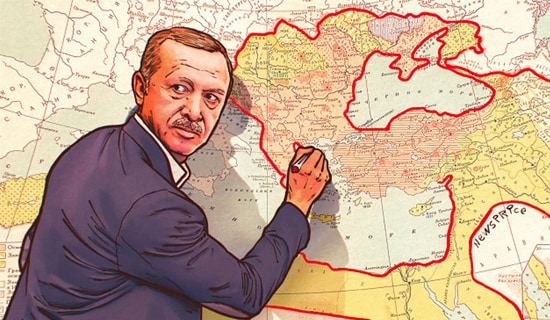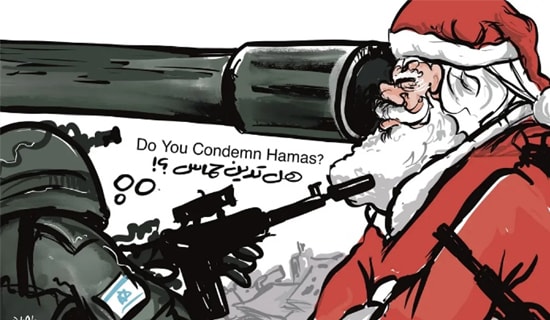It was one of the most astonishing, lopsided military victories in history. A fluke, "a seismic event" as, at most, 2,000 ISIS Jihadist fighters took over the Iraqi city of Mosul on June 10, 2014, 10 years ago, from tens of thousands of Iraqi government soldiers, police, and paramilitary forces.[1] It is true that the corrupt, sectarian regime of Prime Minister Nuri Al-Maliki had hollowed out and politicized the security forces but still ISIS was outnumbered (and outgunned) 10 or 20 to one.

Image from an ISIS gun shop in Mosul, 2015
But ISIS was able to leverage propaganda and aggressive attacks and terrorism on the ground into a toxic mix that would undermine morale and the will to fight of most Iraqi security forces. The Iraqi government was even able to corner and kill key ISIS commander Abu Abdulrahman Al-Bilawi, who was leading the Mosul attack, on June 4, and yet still the city fell. Salil Al-Sawarim Part Four, the hour-long ISIS war video released just two weeks before the Mosul operation would set the stage for the conquest of the city.[2]
ISIS took Mosul in six days, would hold it for almost three years and it would take the Iraqi security forces, backed by American airpower and intelligence, more than six bloody months to take it back when Operation "We are Coming, Nineveh" was launched in late 2016. Much of the city of Mosul was reduced to rubble.
Chances of ISIS ever coming back to power in Iraq seem slim, and its defeat in Mosul was extremely bloody and, seemingly, decisive.[3] The Islamic State has struggled in the Middle East since then but found success elsewhere. After suffering heavy losses in Syria and Iraq the group has found fertile fields in Afghanistan and Central Asia, and in Africa. The recent bloody attack in Moscow, at the Crocus City concert hall in March 2024 is ample proof of the group's lethality and ambitions, in this case carried out by the growing Islamic State Khorasan Province (ISKP) branch.[4] There is little doubt that the organization has ambitious dreams and still seeks high profile targets worldwide.[5]
But in Iraq, deaths from terrorism are way down. ISIS is a threat but the Iraqi state, at least its security component aimed against Sunni Jihadism, seems much stronger today than it was a decade ago. This is true even though that state is deeply compromised by its intimate relationship and interdependence with pro-Iranian militias and parties that are a law unto themselves.
So, the ISIS victory in June 2014 at Mosul was both astonishing and ephemeral. Aside from savage, well-publicized brutality and widespread destruction it seems to have left very little behind in terms of a tangible heritage.
Yet if we look more closely, there are perhaps tangible results – real things – that came out of Mosul. Certainly, the ISIS way of doing propaganda had a tremendous effect on the propaganda of rival terrorist groups, encouraging them to improve their content. Hour-long 1080p fully high-definition videos with good production value that ISIS produced at its height right before and after the fall of Mosul were, at the time, a remarkable accomplishment. So was the ISIS delivery system leveraging multiple nodes on Western-owned social media to get their message out. We still hear, years later, of young people being radicalized by old, hard-to-get ISIS videos.[6] They still retain their power. And yet the content of the videos set the stage for the group's decline. What excited some, caused deep revulsion in others. And videos of the killings of Americans such as James Foley and Steven Sotloff in late 2014 not only galvanized American military action against the group but also put pressure on social media companies to sanitize their content.
The ISIS way of war, both before the fall of Mosul and especially in the defense of the city in 2016 against Iraqi security forces also had an impact. The Islamic State were not the originators of using drones in battle but they certainly publicized such use aggressively. Today, videos of drones striking targets following in the footsteps of ISIS can be seen from Sudan to Ukraine. Another astonishing weapon used was the deployment of multiple suicide vehicle-borne improvised explosive devices (SVBIEDs) – 10 to 15 a day in 2016 – against Iraqi security forces, a terrifying weapon against advancing coalition forces.[7] American airpower helped neutralize this threat but ISIS SVBIEDs have subsequently appeared as far away as Nigeria and the Philippines.[8]
A third result of the ISIS victory in Mosul was, of course, the declaration of the Caliphate itself by Abu Bakr Al-Baghdadi in July 2014 in Mosul's Al-Omari Mosque. The Islamic State had previously inched toward announcing a caliphate (2006-2010, with "Commander of the Faithful," Abu Umar Al-Baghdadi)[9] but it would be with Mosul's fall that the group would unabashedly embrace the old supreme title of Sunni Islam. Since then, even after Abu Bakr Al-Baghdadi's death in 2019, the Islamic State would continue to announce, and subsequently lose to enemy airstrikes, successive, increasingly "faceless caliphs." The latest, Abu Hafs Al-Hashimi Al-Qurashi is the fifth in line since that fateful day in Mosul a decade ago, and the fourth since Abu Bakr Al-Baghdadi's death. Given their short lifespan, not much is known about the latest ISIS shadow caliph.
Sadly, in contrast to ISIS propaganda, ISIS warmaking and ISIS caliphs, the most lasting and tangible result of that ISIS victory in Mosul has been the destruction of non-Muslim minority communities in Northern Iraq.[10] The ISIS conquest of Mosul would lead to the displacement of the entire Iraqi Christian population in the city, an ancient community that would be ethnically cleansed, pushed out with only the clothes on their backs in July 2014.[11] Mosul's Christian community has yet to recover. Thousands were expelled, and only – at most – a few hundred have returned. Historic church buildings are being restored (including by friendly Muslim governments and local Muslims) but the native Christian community has mostly scattered.
Subsequent ISIS offensives after the taking of Mosul in 2014 would strike near fatal wounds at the Yazidi community at Jebel Sinjar and at the Christian community in the towns on the Nineveh Plain. While less complete than what happened inside the city of Mosul, recovery for both communities after the fall of ISIS in 2017 has been slow and difficult.[12] Ironically, the recovery of both Christians and Yazidis in Northern Iraq has been made much harder by the sectarian hooliganism of Shia militias supported by the government and initially created to fight ISIS.[13] Sunni Muslim triumphalism was replaced by Iranian-guided Shia Islamic supremacists.[14] Iraq today is less diverse and pluralistic than it has been for centuries. The greatest victory of the Islamic State in Mosul was to create copycats.
*Alberto M. Fernandez is Vice President of MEMRI.
[1] Warontherocks.com/2014/07/inside-the-collapse-of-the-iraqi-armys-2nd-division, July 1, 2014.
[2] Jihadica.com/is-this-the-most-successful-release-of-a-jihadist-video-ever, May 19, 2014.
[3] Icct.nl/publication/low-likelihood-isis-resurgence-iraq, May 31, 2024.
[4] Foreignpolicy.com/2024/04/10/islamic-state-is-k-isis-moscow-concert-attack, April 10, 2024.
[5] Jpost.com/israel-news/article-795314, April 4, 2024.
[6] Palmbeachpost.com/story/news/crime/2022/01/13/corey-johnson-gets-life-prison-sentence-2018-sleepover-murder-teen/9197838002, January 13, 2022.
[7] Rand.org/pubs/research_briefs/RBA388-1.html, February 12, 2021.
[8] Mei.edu/sites/default/files/2019-04/Car_Bombs_as_Weapons_of_War.pdf, April 2019.
[9] Hudson.org/nationAl-security-defense/the-caliphate-attempted-zarqawi-s-ideologicAl-heirs-their-choice-for-a-caliph-and-the-collapse-of-their-self-styled-islamic-state-of-iraq, July 1, 2008.
[10] Nbcnews.com/storyline/iraq-turmoil/has-last-christian-left-iraqi-city-mosul-after-2-000-n164856, July 27, 2014.
[11] See MEMRI Daily Brief No. 53, The ISIS Caliphate and the Churches, August 27, 2015.
[12] See MEMRI Daily Brief No. 127, Want To Defeat The Legacy Of ISIS? Try Rebuilding Non-Muslim Communities It Has Destroyed, May 25, 2017.
[13] See MEMRI Daily Brief No. 320, Will Iranian-Controlled Christian Tokenism Increase In Iraq's Elections?, September 29, 2021.
[14] Atlanticcouncil.org/blogs/menasource/three-years-after-the-caliphate-iraqs-christians-find-little-incentive-to-return, June 9, 2024.





